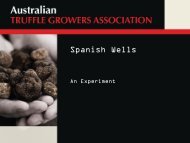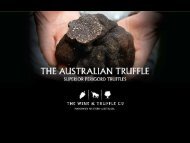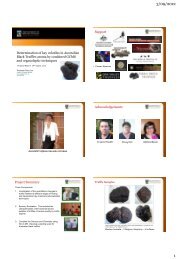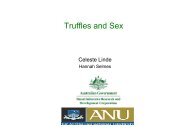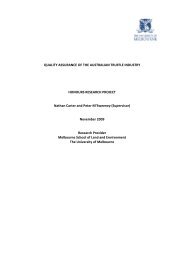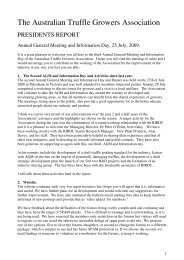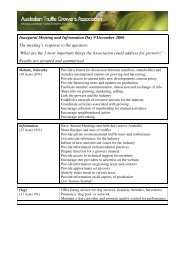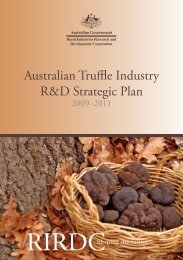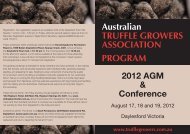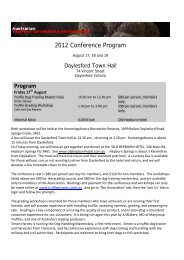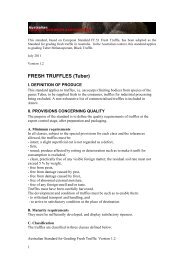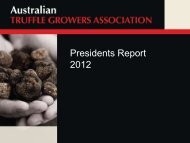PowerPoint - Australian Truffle Growers Association
PowerPoint - Australian Truffle Growers Association
PowerPoint - Australian Truffle Growers Association
- No tags were found...
You also want an ePaper? Increase the reach of your titles
YUMPU automatically turns print PDFs into web optimized ePapers that Google loves.
Determination of key volatiles in <strong>Australian</strong>Black <strong>Truffle</strong>s aroma by combined GCMSand organoleptic techniquesProfessor Garry LeeCentre For Forensic ScienceGarry.Lee@uwa.edu.au0402 342090
Support• Blue Frog <strong>Truffle</strong>s• Flamen Nominee• Macenmist
Project SummaryThree Components1. Investigation of the quantitative changes intruffle volatiles at different stages of fruiting anddevelopment by chemical instrumentationtechniques.2. Sensory Evaluation. This includes thecharacterisation of the essential aroma qualitiesof truffles of various quality by truffle experts.3. Correlate the Sensory and Chemistry using GC-O-MS . Develop a grading scale for <strong>Australian</strong>black truffles.
Project & Future Outcomes1. Grading Scale for <strong>Australian</strong> Black <strong>Truffle</strong>2. An accurate aroma profile for <strong>Australian</strong> Black <strong>Truffle</strong>s– Used to develop oils– Train Dogs3. Electronic Nose.
Why are we doing this?The West <strong>Australian</strong>, February 15 th , 2011
What is it thatwe desire from a<strong>Truffle</strong>?
<strong>Australian</strong> – New Zealand Standardfor <strong>Truffle</strong>s• Based on physical and morphological Aspects.• Grade A –<strong>Truffle</strong>s in this class should be of the highest quality. They should beof regular shape and sufficiently mature to have the characteristic aroma, tasteand colour of the species, with only very slight damage.• Grade B –<strong>Truffle</strong>s in this class may include those that have been damaged orbroken but are sufficiently mature to have the characteristic aroma, taste andcolour of the species. They may have some shape imperfections and predatordamage. It includes truffle pieces greater than 100 g.• Grade C –<strong>Truffle</strong>s in this class comprise smaller truffle pieces, which havebeen broken or cut from larger truffles but are sufficiently mature to have thecharacteristic aroma, taste and colour of the species, but will contain defectsand damage marks.• Grade D –<strong>Truffle</strong>s in this class are immature truffles with little or no aroma andprimarily aimed at the manufacturing industries.
<strong>Australian</strong> – New Zealand Standardfor <strong>Truffle</strong>s• Other Provisions.• Size – Bands: Special (750g +), 250-750g, 100-250g, 20-100g, 0-20g. .• Quality – Maturity: The aroma must be sufficiently developed and must displaysatisfactory ripeness for the grade allocated.• Minimum Requirements – <strong>Australian</strong> origin, firm, clean, intact, free from pest,damage, foreign visible matter etc.• Tolerances
UNECE STANDARD FFV-53• Based on physical and morphological Aspects.• “Extra” Class –<strong>Truffle</strong>s in this class must be of superior quality. They must be characteristic of thespecies.They must have a rounded shape, more or less regular and lobed.They must be free from defects, with the exception of very slight superficial defects as well as very slightdefects in appearance, shape and colour, provided these do not affect the general appearance of theproduce, the quality, the keeping quality and presentation in the package.• Class I – <strong>Truffle</strong>s in this class must be of good quality. They must be characteristic of the species.The following slight defects, however, may be allowed, provided these do not affect the generalappearance of the produce, the quality, the keeping quality and presentation in the package:• a slight defect in shape• a slight defect in development• slight defects in colouring• slight superficial bruising.• Class II– This class includes truffles that do not qualify for inclusion in the higher classes but satisfy theminimum requirements specified above.The following defects may be allowed, provided the truffles retain their essential characteristics asregards the quality, the keeping quality and presentation:• defects in shape• defects in development• defects in colouring• superficial bruising• slight superficial damages caused by pests provided they are not developing.
Which one is the Market Grade?
Cost to Industry and Customers• Damage to Industry Reputation• Industry not getting it’s worth in smaller truffles• Customers not getting what they paid for
Good Quality or Not?
Size?
Chemical Profile of <strong>Truffle</strong>s• <strong>Truffle</strong>s:– Western Australia: 3 regions– New South Wales: 2 regions– Canberra• Immature, Mature & Rottten• Grade A, B and C (Graded by individualSources)• Received fresh or vacuum packed• Stored at 4 °C wrapped in paper towel inglass container.• Used within 2 days of possession
Analytical MethodologySolid Phase Microextraction• Varying temperatures.• Four different SPME fibres were investigated.• Combination of three different stationary phases(divinyl benzene (DVB), carboxen (CAR) andpolydimethylsiloxane (PDMS).• GC-MS column - polyethylene glycol (AT-wax)stationary phase
Analytical MethodologyPurge and Trap• Solid Sample<strong>Truffle</strong> subsample was chopped into fine pieces, placedin a 40 mL purge and trap vial, heated to 80 o Candsparged with helium into a purge and trapconcentrator equipped with a Supelco Vocarb 3000absorbent trap and attached to a GC-MS.• Water Extraction15 mL of water was added to one gram of chopped trufflesample in a 40 mL vial and sonicated prior tosparging with helium.• Methanol ExtractionOne gram of chopped truffle sample was extracted with10 mL of methanol. 1 mL of this solution was addedto 41 mL of water. 5 mL of this solution was thensparged with helium.
ResultsCompoundT. melanosporum (Relative % from top 30 peaks)Region 1 Region 1(1 week old)Region 2*Literaturedimethylsulphide 8.7 1.4 2.82 17.5Formic acid, 1‐methylethyl ester 10.17 0.88 0 02‐butanone 1.92 1.23 1.08 15.6Butanal, 2‐methyl 1.66 20.22 2.66 0ethanol 1.66 3.29 12.42 13.5Formic acid, 1‐methylpropyl ester 29.48 10.45 1.34 02‐butanol 0.29 0 0 5.251‐propanol, 2‐methyl 6.99 7.29 10.24 01‐Butanol, 2‐methyl 7.88 27.37 45.89 6.18Benzene, methoxy (anisole) 4.18 1.61 0.94 0Benzene, 1‐methoxy‐3‐methyl 3.91 7.78 0.63 0*March et al., International Journal of Mass Spectrometry, 249-250 (2006), p60-67
Ethyl AcetateAbundance40000003500000TIC: T35_610_Acetone_2306.D\ data.msTIC: T042_Acetone_2306.D\ data.msTIC: T28_510_Acetone_2306.D\ data.ms• Black, Fresh truffle• Red, Old truffle (3 weeks)• Blue, rotten truffle30000002500000200000015000001000000500000Time-->04.76 4.78 4.80 4.82 4.84 4.86 4.88 4.90 4.92 4.94 4.96 4.98 5.00 5.02 5.04 5.06
HexanalAbundance20000001800000• Black, Fresh truffleTIC: T35_610W_S.D\ data.msTIC: T042W_S.D\ data.msTIC: T28_510W_S.D\ data.ms• Red, Old truffle (3 weeks)• Blue, rotten truffle1600000140000012000001000000800000600000400000200000Time-->07.20 7.40 7.60 7.80 8.00 8.20 8.40 8.60 8.80 9.00 9
Evolving Volatiles• Fresh truffles had relatively fewer peaks = relatively few compoundsin its volatile profile.• Ageing and decomposing truffles had many compounds and hencemany more peaks in their chromatograms.• Rotten truffles appeared to be more odorous than the fresher truffles.• Fresh truffles had higher concentrations of heavier molecules such as9,12-octadecanoic acid and its esters.• The less fresh and rotten samples had lower concentrations of theseheavier fractions, but higher concentrations of smaller, andapparently the decomposition compounds of these heaviermolecules.
Butanoic AcidAbundance950000900000850000800000750000700000650000600000• Black, Fresh truffleTIC: T35_610_Acetone_2306.D\ data.msTIC: T042_Acetone_2306.D\ data.msTIC: T28_510_Acetone_2306.D\ data.ms• Red, Old truffle (3 weeks)• Blue, rotten truffleTime-->5500005000004500004000003500003000002500002000001500001000005000007.00 7.50 8.00 8.50 9.00 9.50 10.00 10.50
Preliminary Indicator CompoundsFresh and Healthy <strong>Truffle</strong>s haveHigher Concentrations of:9,12-octadecanoic acid and itsestersEthyl acetateDimethyl sulphide2-methyl butanalAcetaldehydeDecomposing and Rotten <strong>Truffle</strong>shave Higher Concentrations of:2-methyl propionic acid2,3-butanediolLinoleic acid ethyl ester3-pentene-2-one3-hexene-2-oneButanoic acidPropanoic acidButanoic acid-2-methylHexanoic acid-2-methylEthanol
Chef Sensory Workshop
Experts Sensory Workshop
Methodology• Each participant will be given a sample of green and red bell peppers.• Participants are not allowed to discuss their answer with other participants.• Open the container given and sniff the bell peppers.• Write down the words best describe bell peppers in the description formsprovided.• Please allow 5 to 10 seconds rest before the next sniff.• Each participants will be asked to provide one description that is differentfrom other participants.• Discussion and scoring of descriptors• Run the test again using truffle sample instead of bell peppers.
Results – Grade “A” <strong>Truffle</strong>s<strong>Truffle</strong> Vote A Vote B Vote C Marks Final GradeChef Experts Chef Experts Chef Experts Chef Experts Chef Experts272 0 1 5 1 2 3 12 8 B C274 1 2 6 2 0 1 15 11 B B492 5 1 1 0 1 4 18 7 A C494 1 0 5 4 1 1 16 9 B B292 1 1 3 1 3 3 12 8 B C194 2 0 4 4 1 1 15 9 B B374 3 1 1 4 3 0 14 11 B B614 4 4 2 0 1 1 17 13 A A634 2 0 2 4 3 1 13 9 B B524 6 3 1 1 0 1 20 12 A B
Results – Grade “B” <strong>Truffle</strong>s<strong>Truffle</strong>Vote A Vote B Vote C Marks Final GradeChef Experts Chef Experts Chef Experts Chef Experts Chef Experts271 1 0 4 5 2 0 13 10 B B273 0 0 4 2 3 3 11 7 C C471 2 2 2 1 3 2 13 10 B B473 4 1 2 3 1 1 17 10 A B291 5 2 1 2 1 1 18 11 A B193 0 0 2 2 5 3 9 9 C B171 1 2 5 1 1 2 14 10 B B373 3 2 2 2 2 1 15 11 B B393 5 0 1 1 1 4 18 6 A C513 0 0 0 3 7 2 7 8 C C511 3 2 4 3 0 0 17 12 A B
Results – Grade “C” <strong>Truffle</strong>s<strong>Truffle</strong>Vote A Vote B Vote C Marks Final GradeChefs Experts Chefs Experts Chefs Experts Chefs Experts Chefs Experts496 2 1 5 0 0 4 16 7 B C495 4 1 3 1 0 3 18 8 A C296 0 0 7 2 0 3 14 7 B C295 5 0 2 2 0 3 19 7 A C476 1 1 5 1 1 3 14 8 B C175 3 2 3 1 1 2 16 10 B B376 1 2 5 1 1 2 14 10 B B396 5 1 2 1 0 3 19 8 A C
Results – Descriptors, Grade “A”<strong>Truffle</strong>sDescriptor Additional descriptor Strength ChemicalDark Chocolate2‐methyl butanalcaramelizedStrong to medium 3‐methyl butanalmaltOctanoic acidSeaweed Medium dimethylsulfideEarthy Fungus/soil Strong 1‐octan‐3‐olMustyMediumYeast Microbiological MediumMushroom Strong 1‐octen‐3‐oneFruity Fruit cake WeakFormic acid, 1‐methyleythl esterEthyl ButyrateEthyl‐3‐methyl‐butyrateGround Coffee Woody Weak 5‐Methyl‐2‐phenyl‐2‐hexenalShearing shed/dampWet hay/straw VegetativeWet rotting leavesNutty Strong to medium Decanoic acid ethyl esterFresh tobacco dried vegetative weakCompostWeakTreacleGreen/sweetweakhexanalhexanol
Results – Descriptors, Grade “B &C” <strong>Truffle</strong>sAmmonia/PungentDamp/MoistClayCaramelDryMushroomFungusCold Roast MeatSour/AcidicDark ChocolateNuttyCompostEarthyMuskyGrade “B”MediumWeakWeakWeakStrongStrongStrong to MediumWeakWeakWeakWeakStrongStrongStrongWet Fur (dog)Rotting Leaves/CompostMouldDryAmmoniaMuskyYeastSweet CornMushroomDampEarthyGrade “C”WeakWeakMediumWeakStrongWeakMediumWeakWeakWeakWeak
Sensory Panel Training
What next?
GC-O Technique• Link between sensory data and chemical data• Data reduction technique – main compounds responsible for sensory stimulus can beseparated from other ‘extraneous’ information• Chemical data can be ‘intelligently’ related to sensory attributes to obtain ‘meaningful’ datato guide industry and solve complex questionsTime IntensityPerceptualMeasurementGC/MS outputTenax TrapVoice RecorderSniff PortGC/MS
5.00 10.00 15.00 20.00 25.00 30.00 35.00Volatile and aromagram profilesAbundance1.25e+071.2e+071.15e+071.1e+071.05e+071e+079500000Ethyl ButyrateOOTIC: LC2E72A.DTIC: CO-72C.D (*)GC/MS profile90000008500000800000075000007000000ONN650000060000005500000500000045000004000000O3500000300000025000002000000150000010000005000000HOOTime-->160140120“fruity”“earthy”LCBCOOdour Intensity1008060“violets”“caramel”402000 5 10 15 20 25 30 35 40Time (mins)Principal aromagram profile
Nano-sensor
Traditional Gas and Vapour Sensors1. Traditionally, the active sensing material of gas sensors is based onsemiconducting metal oxides2. Limitations of these sensors include:• High operating temperatures• Increased energy consumption• Relatively large physical dimensions required for sufficient gas adsorption3. In addition, other materials have been utilised including silicon devices,polymer-carbon black composites and organic materials.
Carbon Nanotube• High surface area and large aspect ratios• Ability to reduce sensor platform dimensions• Room temperature sensing potential• Low power consumption — i.e. cost effective• Chemical modification capabilities for increased sensitivity and specificityto target analytes
Sensor Testing Facility• Dynamic vapour deliver system:– Vapour generation from multi-phase analyte (gases, vapours of liquids & solids)– Large dynamic vapour concentration range – ppt to ppm (analyte dependent)– Magnitude of gas analytes & environments– Automated time-based command prompts– Chemical interference studies – humidity, environmental spikes, etc.
Acknowledgements• Kenny Choo, Honours Student, Curtin University• Associate Professor Hanna Williams, Curtin University• Al Blakers – Manjimup <strong>Truffle</strong>s• Harry Eslick – Wine and <strong>Truffle</strong> Company• Adam Wilson – Great Southern <strong>Truffle</strong>s• Damon Boorman• Wayne Haslam – Blue Frog <strong>Truffle</strong>s• Jenna Valentin, University of Western Australia




